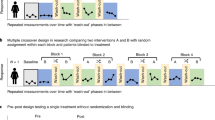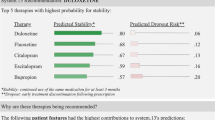Abstract
The medical field has undergone a quiet revolution during the past three decades. Patients have been brought into the treatment decision process as never before. Gone are the days when the patient was delivered the diagnosis and simply told how their disorder was to be treated. Rather, widespread use of shared decision making has changed the way that patients and their physicians interact. The development of best clinical practices from concepts of evidence-based medicine has shown that, for many disorders, the various treatment options result in near-equivalent outcomes. More recently, the democratization of medical information by the internet has made the patient a much better informed consumer, and thus a more active participant in his or her own care.
Key Points
-
Patients are anxious to expand their understanding of their disorder
-
The physician is not always the patient's primary source of data: find out what other sources your patients are using to help make their decisions
-
Identify the issues that patients hold as most important when making medical decisions; be aware that personal beliefs may differ based on the disease state
-
Never forget the potent effect of spirituality on decision making
-
The Internet has a myriad of sites devoted to patient decision making: become familiar with those related to your specialty
This is a preview of subscription content, access via your institution
Access options
Subscribe to this journal
Receive 12 print issues and online access
$209.00 per year
only $17.42 per issue
Buy this article
- Purchase on Springer Link
- Instant access to full article PDF
Prices may be subject to local taxes which are calculated during checkout

Similar content being viewed by others
References
Lam JS et al. (2004) Changing concepts in the surgical management of renal cell carcinoma. Eur Urol 45: 692–705
Leibovich BC and Blute ML (2006) Surgical management of renal cell carcinoma. Semin Oncol 33: 552–562
Nelson EC et al. (2007) Renal cell carcinoma: current status and emerging therapies. Cancer Treat Rev 33: 299–313
Greenlee RT et al. (2000) Cancer Statistics, 2000. CA Cancer J Clin 50: 7–33
Hernandez J and Thompson IM (2004) Diagnosis and treatment of prostate cancer. Med Clin North Am 88: 267–279
Johansson JE et al. (2004) Natural history of early, localized prostate cancer. JAMA 291: 2713–2719
Walsh PC et al. (2007) Clinical practice. Localized prostate cancer. N Engl J Med 357: 2696–2705
Kinchen KS et al. (2004) Referral of patients to specialists: factors affecting choice of specialist by primary care physicians. Ann Fam Med 2: 245–252
van Dalen I et al. (2001) Motives for seeking a second opinion in orthopaedic surgery. J Health Serv Res Policy 6: 195–201
Gertman PM et al. (1980) Second opinions for elective surgery. The mandatory Medicaid program in Massachusetts. N Engl J Med 302: 1169–1174
Schlossberg S et al. (1984) Second opinion for urologic surgery. J Urol 131: 209–212
Bromage SJ et al. (2007) Tailoring urological outpatient services to patient choice. J Eval Clin Pract 13: 476–479
Goodman DC (2004) Do we need more physicians? Health Aff (Millwood) (Suppl) W4: 67–69
Birkmeyer JD et al. (2003) Regionalization of high-risk surgery and implications for travel times. JAMA 290: 2703–2708
Davison BJ and Goldberg SL (2003) Decisional regret and quality of life after participating in medical decision-making for early-stage prostate cancer. BJU Int 91: 14–17
Robinson A and Thomson R (2001) Variability in patient preferences for participating in medical decision making: implication for the use of decision support tools. Qual Health Care 10: 34–38
Mazur DJ and Hickam DH (1997) Patients' preferences for risk disclosure and role in decision making for invasive medical procedures. J Gen Intern Med 12: 114–117
Mazur DJ et al. (2005) The role of doctor's opinion in shared decision making: what does shared decision making really mean when considering invasive medical procedures? Health Expect 8: 97–102
Montgomery AA and Fahey T (2001) How do patient's treatment preferences compare with those of clinicians? Qual Health Care 10 (Suppl 1): 39–43
Ruiz-Morl R et al. (2006) Physician–patient communication: a study on the observed behaviours of specialty physicians and the ways their patients perceive them. Patient Educ Couns 64: 242–248
Watson V et al. (2004) Eliciting preferences for drug treatment of lower urinary tract symptoms associated with benign prostatic hyperplasia. J Urol 172: 2321–2325
Thomas K et al. (2005) Acute urinary retention: what is the impact on patients' quality of life? BJU Int 95: 72–76
Wills CE et al. (2006) Treatment preference patterns during a videotape decision aid for benign prostatic hyperplasia (BPH). Patient Educ Couns 61: 16–22
Piercy GB et al. (1999) Impact of a shared decision-making program on patients with benign prostatic hyperplasia. Urology 53: 913–920
Ogan K et al. (2001) Parental preferences in the management of vesicoureteral reflux. J Urol 166: 240–243
Kuo RL et al. (1999) Incorporation of patient preferences in the treatment of upper urinary tract calculi: a decision analytical view. J Urol 162: 1913–1918
Andersen MH et al. (2007) Quality of life after randomization to laparoscopic versus open living donor nephrectomy: long-term follow-up. Transplantation 84: 64–69
Denberg TD et al. (2006) Patient treatment preferences in localized prostate carcinoma: the influence of emotion, misconception, and anecdote. Cancer 107: 620–630
Berry DL et al. (2003) Treatment decision-making by men with localized prostate cancer: the influence of personal factors. Urol Oncol 21: 93–100
Steginga SK et al. (2002) Making decisions about treatment for localized prostate cancer. BJU Int 89: 255–260
Holmboe ES and Concato J (2000) Treatment decisions for localized prostate cancer: asking men what's important. J Gen Intern Med 15: 694–701
Hall JD et al. (2003) Why patients choose prostatectomy or brachytherapy for localized prostate cancer: results of a descriptive survey. Urology 61: 402–407
Klotz L (2007) Active surveillance for favorable risk prostate cancer: rationale, risks, and results. Urol Oncol 25: 505–509
Pickles T et al. (2007) Psychosocial barriers to active surveillance for the management of early prostate cancer and a strategy for increased acceptance. BJU Int 100: 544–551
Latini DM et al. (2007) The relationship between anxiety and time to treatment for patients with prostate cancer on surveillance. J Urol 178: 826–831
Eakin EG and Strycker LA (2001) Awareness and barriers to use of cancer support and information resources by HMO patients with breast, prostate, or colon cancer: patient and provider perspectives. Psychooncology 10: 103–113
Smith RL et al. (2002) An evaluation of the Man to Man self-help group in Colorado and Utah. Cancer Pract 10: 234–239
White M and Verhoef M (2006) Cancer as part of the journey: the role of spirituality in the decision to decline conventional prostate cancer treatment and to use complementary and alternative medicine. Integr Cancer Ther 5: 117–122
Chan JM et al. (2005) Total and specific complementary and alternative medicine use in a large cohort of men with prostate cancer. Urology 66: 1223–1228
Ponholzer A et al. (2003) Frequent use of complementary medicine by prostate cancer patients. Eur Urol 43: 604–608
Boon H et al. (2003) Men with prostate cancer: making decisions about complementary/alternative medicine. Med Decis Making 23: 471–479
Boon H et al. (2003) Use of complementary/alternative medicine by men diagnosed with prostate cancer: prevalence and characteristics. Urology 62: 849–853
Diefenbach MA et al. (2003) Clinical, demographic and psychosocial correlates of complementary and alternative medicine use by men diagnosed with localized prostate cancer. J Urol 170: 166–169
Silvestri GA et al. (2003) Importance of faith on medical decisions regarding cancer care. J Clin Oncol 21: 1379–1382
Balboni TA et al. (2007) Religiousness and spiritual support among advanced cancer patients and associations with end-of-life treatment preferences and quality of life. J Clin Oncol 25: 467–468
Daugherty CK et al. (2005) Trusting God and medicine: spirituality in advanced cancer patients volunteering for clinical trials of experimental agents. Psychooncology 14: 135–146
Ottawa Health Research Institute web site http://decisionaid.ohri.ca (accessed 30 June 2008)
Author information
Authors and Affiliations
Corresponding author
Ethics declarations
Competing interests
The authors declare no competing financial interests.
Rights and permissions
About this article
Cite this article
Hellenthal, N., Ellison, L. How patients make treatment choices. Nat Rev Urol 5, 426–433 (2008). https://doi.org/10.1038/ncpuro1189
Received:
Accepted:
Issue Date:
DOI: https://doi.org/10.1038/ncpuro1189
This article is cited by
-
Exploring the impact of providing men with information about potential prostate cancer treatment options prior to receiving biopsy results
Supportive Care in Cancer (2020)
-
Do we really allow patient decision-making in rotator cuff surgery? A prospective randomized study
Journal of Orthopaedic Surgery and Research (2019)
-
Health numeracy in Japan: measures of basic numeracy account for framing bias in a highly numerate population
BMC Medical Informatics and Decision Making (2012)
-
Perception of Direct‐To‐Consumer Genetic Testing and Direct‐To‐Consumer Advertising of Genetic Tests among Members of a Large Managed Care Organization
Journal of Genetic Counseling (2012)
-
Selbsthilfe im Onlineforum bei lokal begrenztem Prostatakarzinom
Der Urologe (2010)



